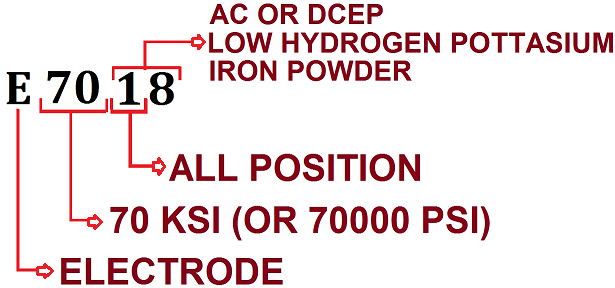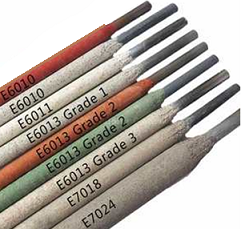Welding rods, which are also known as electrodes, are essentially the welding material that gets melted and infused in processes like stick welding. To use a welding rod, it gets connected to your welding machine which then creates an electric arc between the base metal. Because this electric arc is very hot, it quickly melts the metal so that it can be fused for the welding process.
While taking a look at welding rods, you will mainly find two types of options including consumable and non-consumable welding rods. Out of these two, the consumable ones are used for MIG and stick welding. These welding rods are the more common ones and get used for making up the weld. On the other hand, in case you want to pick TIG welding, then it will most likely have a tungsten welding rod that does not melt. Instead, this welding rod is only used for making the electric arc and the filler material gets fed manually.
Outline
ToggleWhat do the Numbers Mean on a Welding Rod?
Even though we have already discussed the two primary sorts of welding rods out there, you might still get confused while buying the right one for your welding needs. This is due to the reason that you will most likely find multiple numbers written on your welding rod. And those of you who are new to welding machines and their accessories, these can be highly confusing. Thankfully, these numbers are there to help you in picking the right type of welding rod for you.
Taking as an example, let’s say that you are interested in getting a 7018 welding rod, then the two first digits essentially tell you about its tensile strength. In this case, the tensile strength of this 7018 welding rod would be 70000 PSI tensile strength or pounds per square inch tensile strength. As for the third digit, which is 18 in this case, tells you about the number of positions that you can use while using a given welding rod.
Coming to the final digit mentioned on a given welding rod, it tells you about the type of coating that it uses. You can learn more about these later on in this article. In a few cases, some welding rods may also have alphabet E at the beginning which simply tells you that the given welding rod also functions as an electrode while using your welding machine.
Welding Rods and their Types
After going through the section explained above, you must now have a pretty decent idea about what class of welding rods that you wish to get. Although, since there are multiple welding rods available out there, picking the right one can still be quite difficult. Hence, here are some of the most commonly used welding rods types and their characteristics:
- 6010: Starting with the 6010 welding rods, these are one of the most popular options out there as these are ideal for high power density welds. Such welding rods are generally used for pipes, welding in shipyards, steel storage tanks, water towers, and other applications dealing with thick metals. Although, the 6010 type of welding rods can be only used with DC welding machines. Another issue is that since they have a tight arc, handling these welding rods types can be a bit difficult for beginners.
- 6011: Unlike the 6010 welding rods, 6011 welding rods are great for using with either AC or DC welding machines as per your needs. But similar to the previous one, you can expect great penetration from these welding rods which is always great. You can use this class of welding rods for thicker metals, painted surfaces, and even greasy surfaces. However, if you want to have a clean finish, then the ripples, weld beads, and rough finish left by this welding rod might be a letdown for you.
- 6012: A great thing about 6012 welding rods is that even at high currents, you get very less splatter along with a stable arc for easily welding on both AC as well as DC welding machines. However, unlike 6010 and 6011, you cannot use 6012 for thick materials. 6012 welding rods also have an issue of generating a lot of waste material requiring you to clean your welds regularly. You can rely on this welding rod type for open joints, repair welding, and welding carbon steel even if it is rusted and corroded.
- 6013: You can also consider the 6013 welding rods if you want clean results with minimal splatter. And even with its less splatter output, it offers moderate penetration making it viable for a lot of applications. Some of the ideal applications for the 6013 welding rod include welding metal sheets, ship construction and repair, and working on steel surfaces and objects that are mild. Just like most other welding rods, this one can also be used with either AC or DC currents according to your requirements.
- 7018: Out of all the various welding rods out there, the 7018 welding rod is considered to be highly versatile. This is mainly ideal for working on carbon steel of low to moderate quality. Since the 7018 welding rod has an iron compound coating that contains a very small amount of hydrogen, the beads and splatter made from the welding is properly protected from environmental factors like air and the moisture present in it for a clean weld. Along with this, as 7018 welding rod is also compatible with both AC as well as DC welders, it is used in factories, bridges, powerhouses, and all kinds of other heavy-duty uses.
- 7024: A unique thing about the 7024 welding rod type is that it has a high amount of iron power. Because of this, its deposition rate is quite high which can make the welding process quite easy especially for beginners. If your desired application requires a smooth finish, then going with the 7024 welding rod can be a great idea.
Comparison Chart for Welding Rods
Although all the most popular welding rod types have been explained above along with their characteristics and ideal applications, there is still more that you need to keep in mind before buying one. Hence, it is highly recommended to go through the following comparison chart before getting welding rods for your desired application:
| Electrode | Tensile Strength | Position | Penetration | Coating | Current |
| 6010 | 60000 PSI | All positions | Deep | High cellulose sodium | DCEP |
| 6011 | 60000 PSI | All positions | Deep | High cellulose potassium | DCEP, AC |
| 6012 | 60000 PSI | All positions | Medium | High titania sodium | DCEP, AC |
| 6013 | 60000 PSI | All positions | Shallow | High titania potassium | DCEP, AC |
| 7018 | 70000 PSI | All positions | Shallow to Medium | Iron power low hydrogen | DCEP, AC |
What is the Most Common Welding Rod Size?
Apart from the type of welding rod that you are going to use along with your welding machine, you should also consider checking its size rating before getting one. This size simply tells you about the diameter of the welding rods that you are using. Generally, most welding rods that you will find out there range between ⅛ inch to 5/32 inch. Those of you who are getting a welding rod of a similar size, then you should be just fine as long as it is of the right type.
Guide to Choosing a Welding Rod
Now that you know all the major types of welding rods available out there as well as their ideal size, you must be ready to pick the right one. However, even if you want to go with a certain welding rod type, you will still find multiple options within that type. Therefore, you have to consider a lot before getting welding rods which primarily includes these factors:
Base Metal
To get the best results from your welding machine and its welding rod, it is highly important to match the metal of your welding rods with the one that you are going to weld. This ensures that both of them go great along with each other for a high-strength weld. It is highly important to check if you wish your welds to last for a long time.
Metal Appearance
For checking the type of base metal that you are dealing with, you can first check its appearance. If it is something grainy and rough, then it is highly likely that it is some sort of cast metal.
Magnetism
You can also check for magnetism in your base metal as magnetic materials include iron, carbon steel, or alloy steel. Although, if it is not magnetic, then it might be authentic stainless steel, brass, copper, aluminum, or something similar.
Spark Type
Another way to check your base metal can be to run it against a grinder and check the sparks offered by it. If there are a lot of sparks, then it most likely has high carbon content. You may also hit your base metal with a chisel as that can leave marks on softer metals like aluminum.
Tensile Strength
Once you have determined your base metal, you must match your welding rod’s tensile strength to that of the base metal. If they are not the same, the weld may crack over time.
Welding Current
You should also keep the welding current supported by your welding rods before getting one. A higher welding current like 225 amps for 7018 is better than 125 amps for 6010 in most cases. The supported current type out of AC and DC is also important to keep in mind before picking a welding rod for you.
Conclusion
Coming to the end of this welding rod comparison and explanation article, you must know a lot about these welding rods. This includes all their major types and why you should pick a certain type, their size, and even a complete guide to choosing the right welding rod. Hence, you must be already using your welding machine along with the right kind of welding rods that are ideal for your given type of usage. Although, if you have any doubts or anything to add, make sure to share your thoughts in the comments section. You can also post any questions down there if you have any!




4 Responses
THANK YOU FOR THE REFERENCE AND GUIDE FOR THE CORRECT USAGE.
Great information, keep it up.
Thank you.
What an informative part. I would like to know more about aluminium and carbon materials
Thanks
Brilliant and useful article on welding rod.